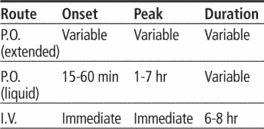Medical term:
ethylenediamine
ethylenediamine
[eth´ĭ-lēn-di″ah-mēn]aminophylline (theophylline, ethylenediamine)
Pharmacologic class: Xanthine
Therapeutic class: Bronchodilator
Pregnancy risk category C
Action
Unclear. Thought to directly relax smooth muscle of bronchial airways and increase pulmonary blood flow by inhibiting phosphodiesterase.
Availability
Injection: 250 mg/10 ml
Oral liquid: 105 mg/5 ml
Tablets: 100 mg, 200 mg
Indications and dosages
➣ Symptomatic relief of bronchospasm in patients with acute symptoms who require rapid theophyllinization
Adults (nonsmokers): 0.7 mg/kg/hour I.V. for first 12 hours. Maintenance dosage is 0.5 mg/kg/hour I.V.
Children ages 9 to 16: 1 mg/kg/hour I.V. for first 12 hours. Maintenance dosage is 0.8 mg/kg/hour I.V.
Children ages 6 months to 9 years: 1.2 mg/kg/hour I.V. for first 12 hours. Maintenance dosage is 1 mg/kg/hour I.V.
➣ Chronic bronchial asthma
Adults and children: Dosage is highly individualized. Common initial dosage is 16 mg/kg/24 hours I.V. or 400 mg/24 hours I.V. in divided doses at 6- or 8hour intervals. If needed, dosage may be increased 25% at 3-day intervals.
Dosage adjustment
• Heart failure
• Hepatic disease
• Elderly patients
• Smokers
Off-label uses
• Dyspnea in patients with chronic obstructive pulmonary disease (COPD)
Contraindications
• Hypersensitivity to xanthine compounds or ethylenediamine
• Seizure disorders
Precautions
Use cautiously in:
• COPD, diabetes mellitus, glaucoma, renal or hepatic disease, heart failure or other cardiac or circulatory impairment, hypertension, hyperthyroidism, peptic ulcer, severe hypoxemia
• active peptic ulcer disease
• elderly patients
• neonates, infants, and young children.
Administration
• For I.V. use, dilute according to label directions and infuse at a rate no faster than 25 mg/minute.
• Don't give in I.V. solutions containing invert sugar, fructose, or fat emulsions.
• Give oral form at meals with 8 oz of water.

Adverse reactions
CNS: irritability, dizziness, nervousness, restlessness, headache, insomnia, stammering speech, abnormal behavior, mutism, unresponsiveness alternating with hyperactivity, seizures
CV: palpitations, sinus tachycardia, extrasystoles, marked hypotension, arrhythmias, circulatory failure
GI: nausea, vomiting, diarrhea, epigastric pain, hematemesis, gastroesophageal reflux, anorexia
GU: urine retention (in men with enlarged prostate), diuresis, increased excretion of renal tubular cells and red blood cells, proteinuria
Metabolic: hyperglycemia
Musculoskeletal: muscle twitching
Respiratory: tachypnea, respiratory arrest
Skin: flushing
Other: fever, hypersensitivity reactions (including exfoliative dermatitis and urticaria)
Interactions
Drug-drug. Adenosine: decreased antiarrhythmic effect of adenosine
Barbiturates, nicotine, phenytoin, rifampin: decreased aminophylline blood level
Beta-adrenergic blockers: antagonism of aminophylline effects
Calcium channel blockers, cimetidine, ciprofloxacin, disulfiram, erythromycin, hormonal contraceptives, influenza vaccine, interferon, methotrexate: elevated aminophylline blood level
Carbamazepine, isoniazid, loop diuretics (such as furosemide): increased or decreased aminophylline blood level
Ephedrine, other sympathomimetics: toxicity, arrhythmias
Lithium: increased lithium excretion
Drug-diagnostic tests. Aspartate aminotransferase, glucose: increased levels
Drug-herbs. Cayenne: increased risk of aminophylline toxicity
Drug-behaviors. Smoking: increased aminophylline elimination
Patient monitoring
☞ Monitor aminophylline blood level. Adjust dosage if patient has signs or symptoms of toxicity (tachycardia, headache, anorexia, nausea, vomiting, diarrhea, restlessness, and irritability).
• Assess for arrhythmias, especially after giving loading dose.
• Check vital signs and fluid intake and output.
• Monitor patient's response to drug, and assess pulmonary function test results.
Patient teaching
• Advise patient to take oral doses at meals with 8 oz of water.
• Caution patient to avoid driving and other hazardous activities until he knows how drug affects concentration and alertness.
• Tell patient to minimize GI upset by eating small, frequent servings of food and drinking plenty of fluids.
• Advise patient to establish effective bedtime routine to minimize insomnia.
• Caution patient not to change aminophylline brands.
• If patient smokes, tell him to notify prescriber if he stops smoking; dosage may need to be adjusted.
• As appropriate, review all other significant and life-threatening adverse reactions and interactions, especially those related to the drugs, tests, herbs, and behaviors mentioned above.
eth·yl·ene·di·a·mine
(eth'il-ēn-dī'ă-mēn),eth·yl·ene·di·a·mine
(eth'il-ēn-dī'ă-mēn)eth·yl·ene·di·a·mine
(eth'il-ēn-dī'ă-mēn)Latest Searches:
alipogenic - aldolase - albumosuria - alactolyticus - alabamensis - AKTob - Aklomide - akari - aitiology - a-helix - AHCPR - agyric - agophytum - agonists - agglutinogenic - agave - agastria - Agamofilaria - affinitas - aerocystoscopy -
- Service manuals - MBI Corp